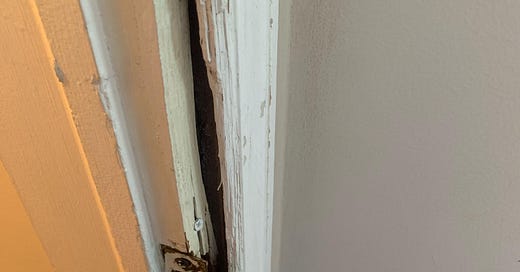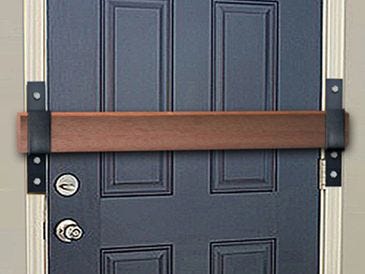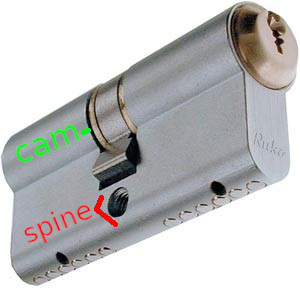Your front door is one of the first lines of defense against intruders, and its material, structure, and additional security measures all play a role in its ability to prevent unauthorized entry. In this blog post, we'll explore the differences in strength and resistance between wood, composite, and steel doors, how your house's construction affects security, and various aftermarket tools you can use to enhance your door's safety without replacing it.
This post will not be discussing all aspects of doors, such as hinges, types of locks, under door attacks, mail slot attacks, etc. This post will be looking at breaching different door types and what level of security they provide you.
I will be using Mr. Eddie Hall as a demonstration for each door type to show how long it would likely take someone to breach into a door type. When deciding what doors to use for your home / business / etc always keep in mind what you believe is the threat level and sophistication of the attackers.
Materials: Wood, Composite, and Steel Doors
Each door material offers different levels of strength and security:
Wood Doors: Known for their aesthetic appeal, wood doors provide a high-end look and are relatively easy to repair in case of scratches or minor damages. However, they require regular maintenance to prevent warping, rot, or peeling due to moisture. While wood doors can be made from solid hardwood for added security, they are generally more expensive and less energy-efficient compared to other materials. Basic wood doors start at around $200 and can go up to $1,000 depending on design and customization .
Regarding security, wooden doors are often the least secure and easiest to breach. While there are a few countermeasures and after market products you can install to increase security, the video below gives some idea as to how secure a standard wooden door is.
Composite (Fiberglass) Doors: Composite doors offer a balance between affordability, strength, and maintenance. They mimic the appearance of wood while providing superior resistance to warping, cracking, and rotting. Composite doors are highly energy-efficient, which can help reduce energy costs. They typically cost between $500 and $2,000 but can go as high as $5,000 for premium designs
Composite doors are becoming much more common because they provide more resistance to breaching while not being as expensive as steel doors. That said, composite doors can still be broken into as the video below shows.
Steel Doors: Steel doors are the most secure option, known for their strength and durability. They are resistant to fire, impact, and most forms of break-in attempts. However, steel doors can be prone to dents, rust, and temperature sensitivity, making them hot or cold to the touch depending on the weather. Steel doors are generally more affordable, with prices ranging from $500 to $2,000, and installation costs between $500 and $1,230
Depending on your needs, steel doors can come in many different levels of thickness and even extend into the wall itself for added security. Steel doors tend to be more secure and resistant against various forms of breaching, however they are not fool proof. Depending on the method of entry and what is on the other side of the door, breaching a steel door can actually be pretty easy as the following video demonstrates. By taking advantage of the crash bar on the other side, only a small hole needs to be drilled into the door in order to grab the crash bar and open the door.
Impact of House Structure on Door Security
The structural material of your house also affects the security of your front door:
Wood-Framed Homes (Common in North America): Wood frames are generally less robust than brick or stone. A wooden frame can be more susceptible to forceful entry methods, such as kicking or using a crowbar. Reinforcing the door frame with metal plates or upgrading to a stronger material can enhance security.
Some things you should always do when trying to secure a door is, if possible, increase the length of the strike plate to be as long as possible to the door frame. Most strike plates are small and the load from someone trying to kick in your door is similarly distributed over a small surface area … but if you increase the size of the strike plate, it distributes the load over a larger area, and often many more screws. This will help prevent attackers from simply kicking in your door. Something like this product
Of course, you also want to ensure that you increase the size of the screws that are holding your strike plate into the door frame. The ones that are usually installed are often criminally small, but by increasing the length you drastically increase the resistance to breaching
Brick or Stone Homes (Common in Europe): Homes constructed with brick or stone provide a stronger, more resistant frame that can better withstand attempts to breach the door. The solidity of the wall material offers additional protection, especially when combined with a steel door or reinforced wood frame.
That said, if an attacker approaches something like a thick steel door on a stone or brick framed house, it still will likely be quicker and easier to go through the wall to remove the door. I will hand it off to Mr. Hall once again to demonstrate
Aftermarket Security Enhancements
If you’re not ready to replace your door, there are several aftermarket tools you can use to improve its security:
Crossbars and Door Braces: These are metal bars that can be placed across the inside of the door, preventing it from being kicked in. A door brace is another option; it anchors to the floor and provides a strong resistance point against forced entry. Prices for crossbars and door braces range from $30 to $150 depending on their quality and strength.
The downside to these of course is that they really change the look of your door from the inside, but if you are concerned with security they will drastically increase your protection level
You can go for something smaller like this product which will do a pretty good job at preventing entry. While it can be shimmed, it is far less visually off putting, just ensure you use long screws and put it near where you think the attacker would be kicking at the door (usually just above or below the lock) … also nothing is stopping you from using more than one.
Reinforced Strike Plates: Upgrading to a heavy-duty strike plate, which is where the lock latches into the frame, can prevent intruders from easily kicking the door open. Reinforced door jambs made of metal or additional wood also offer increased resistance.
As I mentioned above, if you increase the length of the strike plate and the size and length of the screws that go into it, you also drastically increase the protection of the door from being kicked in.
Euro Cylinder Locks: Easy Targets for Breaching
I wanted to a add a quick section to my European readers and explain that it doesn’t matter how awesome your door is if you have the wrong lock. As I have previously written about, many Euro Cylinder locks are vulnerable to snapping and drilling, which is an attack from the outside of a door.
Euro cylinder locks are designed to be quickly interchangeable and their design means that they are held in place by a single screw and the lock itself tends to be very weak which allows attackers to either snap or drill them.
This is a demonstration up close of what this looks like with the lock being inside a vise instead of a door.
In the following clip you will see a police officer doing the same trick to a live lock on a front door, but hopefully you get the idea of how quick an attacker can breach a home regardless as to how strong the door itself is. By the time he has lifted the face plate, you can actually see the lock is already broken and half of it is simply hanging onto the face cover.
How to Improve Security
To prevent lock snapping, consider upgrading to an "anti-snap & drill" euro cylinder, which is designed to withstand these attacks. Installing a cylinder guard or using a lock certified for enhanced security can also significantly reduce the risk.
By understanding these vulnerabilities and upgrading your locks, you can improve the security of your home against common break-in techniques.
Conclusion
Securing your front door involves choosing the right material and considering the structure of your home. Whether you opt for wood, composite, or steel, each material offers unique benefits and drawbacks in terms of strength, maintenance, and cost. Enhancing your existing door with aftermarket security tools can provide an added layer of protection without the need for a complete replacement.
To all my readers who are on an offensive security team, know that it will be up to you to recommend to your client’s the correct doors based on their security threats.
Training Resources:
For individuals looking for a hands on training that includes all of the above topics, Covert Access Team (covertaccessteam.com) provides training courses focused on physical penetration testing, lockpicking, bypassing techniques, social engineering and other essential skills.
Covert Access Training - 5 day hands on course designed to train individuals and groups to become Covert Entry Specialists
Physical Audit Training - 2 day course on how to setup and run a physical security audit
Elicitation Toolbox Course - 2 day course of that primarily focuses on elicitation and social engineering as critical aspects of Black Teaming
Counter Elicitation - 2 day course on how to recognize and prevent elicitation attempts, and safegaurd your secrets.
Cyber Bootcamp for Black Teams - 2 day course designed explicitly for physical penetration testers who need vital cyber skills to add to their toolbox.
Private Instruction - Focused learning & training based on your needs .










